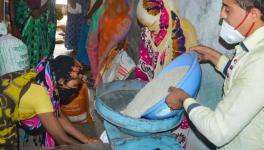Systemic Agrarian Crisis & Changing Contours of Farm Workers

Representational Image. Image Courtesy: Flickr
Manik Ghonshetwad, an agricultural worker from Ambulga village in Mukhed taluka of Nanded district, Maharashtra, works seasonally on farmlands during specific months of the year. He is employed in June and July for cultivation of soybean or cotton, in August and September for weeding (either manually or with herbicides), and in December and January for harvesting. However, this work is not continuous; he is engaged only for a few days in each of these months.
The limited availability of working days in agriculture in his village and neighbouring areas is insufficient to sustain his family’s basic needs. For the rest of the year, he takes up various forms of daily wage labour, as a headload worker, potter, and construction labourer --essentially any job available.
Even during the cultivation and harvesting seasons, Ghonshetwad supplements his income by taking up non-farm manual work whenever possible. He is also a regular worker under MGNREGA (the 100-day rural job guarantee scheme), though his employment depends on the discretion of government and panchayat officials. Additionally, his family's livestock contributes to their income.
Maroti Shivram Mishkire, from the same village, undertakes similar work but also works as a driver to supplement his earnings. Furthermore, he rears pigs, which provide an additional source of income for his household.
The two examples of multi-occupational profiles of agricultural workers, as encountered during a field survey in this village, illustrate the changing nature of work and the rural workforce in India. These highlight how agricultural workers confront shrinking employment opportunities in agriculture. Multiple factors contribute to this shift, including the indiscriminate use of labour-displacing technology and the growing number of workers reliant on agriculture.
We have a situation of an ever-increasing reserve army of workers, who have no gainful employment in the countryside or assured employment in the urban centres to which they migrate. The deep agrarian crisis in India remains the fundamental reason for this situation.
Read Also: The Modi Years: Rural Wages Saw Further Squeeze
Agriculture is one of the largest sectors providing work to the rural population in India. The share of the agricultural sector in employment has been steadily increasing, rising from 44.1% in 2017-18 to 46.1% in 2023-24. As per 2011 Census, India’s total workforce was 48.17 crore. Of this 72% is from a rural background and more than half i.e. 54.6% or 26.3 crore workers are engaged in agriculture.
In our country, the agricultural workforce primarily consists of cultivators and agricultural labourers. A fundamental distinction between these groups, as delineated by the Census of 2011, lies in land ownership arrangements, specifically characterised by the presence or absence of the ‘ownership rights’, ‘right of lease’ or ‘contract on land’. While a cultivator owns land or has a lease or a contract to operate on it, an agricultural labourer does not, as he or she works on land owned by others in return for wages paid in cash or kind.
Additionally, an important section of poor farmers with small, uneconomical holdings are also forced to labour out on others’ farms or take up other menial jobs. Clearly, there is a blurring of the line as to who is a farmer, a tenant farmer or an agricultural worker.
Agricultural labourers constitute an important segment of the rural proletariat engaged in agricultural production. They are the most downtrodden and marginalised class in rural India. Mostly, they are deprived of all resources and most of them are landless, lack access to means of production and rely solely on their labour for sustenance.
Their socio-economic status renders them vulnerable to exploitation, as they are compelled to accept wages dictated by the landlords, mostly below the minimum wages. Moreover, many lack houses, further exacerbating their precarious conditions.
They are not only economically exploited but also endure social marginalisation, confronting pervasive discrimination and violence. Women agricultural workers face gender deprivation, social oppression and receive far lower wages than men for the same kind of work.
Systematic oppression obstructs the inclusion of the agricultural workers in broader development, entrenching cycles of poverty and inequity. Historically marginalised by illiteracy, their children still face poor education, perpetuating limited awareness and hindering progress. Lack of organisation and unionisation hinder collective bargaining, political mobilisation and resultant lack of exposure to political struggles as well as politicisation.
Agricultural workers were a major part of bonded labour in India. Bonded labour represents the most extreme form of social and economic oppression. The bondage arises from indebtedness and debt burden and is passed from one generation to another. It was known by different names in different parts of the country, such as Hali in Gujarat, Kamia in Bihar, Harwaha in Madhya Pradesh, Gothi in Andhra Pradesh, Jeetha in Karnataka and so on.
Many migrant labourers in the Green Revolution areas were forced to submit themselves due to their helpless situation, to various restrictions imposed by the land owners, virtually reducing them to bonded labourers. In the feudal rural structure, the landless families still depend on landlords and rich farmers for their livelihood and are forced to work on their dictates. Agricultural workers may be legally freed from bonded labour, but in reality, a large number are bound by contracts at meagre wages to escape the clutches of unemployment.
After the country’s Independence, the number of agricultural workers has grown rapidly, especially after the implementation of neoliberal economic policies over the past three decades. The overall number of agricultural workforce in the four decades from 1960 to 2001 consisted of more cultivators than labourers.
However, in Census 2011, for the first time in Indian history, this trend was turned around. The Census revealed that the share of cultivators was less than half (about 45%) and that of agricultural labourers was close to 55% in the total agricultural workforce. In real terms, the total number of cultivators, both main and marginal, is 11,86,69,264, whereas agricultural workers are 14,43,29,833. Back in 1961, there were about 33 labourers for every 100 cultivators; in 2011, there were now about 121 labourers for every 100 cultivators.
There are various reasons for the increase in number of farm workers, but the important reason is the pauperisation of farmers, especially after the implementation of neo-liberal economic policies. With the implementation of these policies, State support for agriculture has reduced, resulting in an exorbitant increase in input costs and no guarantee of minimum support price (MSP) or procurement for agricultural produce.
Hence the whole agriculture production process has become more uncertain. Earlier, weather was the only uncertainty for farmers. They were afraid of drought and rain, but now market uncertainties are harsher than those of nature. When profit is the only guiding force, the lives of agricultural workers hardly stand anywhere.
This persistent agrarian crisis is displacing small and marginal farmers and forcing them to leave agriculture, as it fails to support the livelihood of their families. Studies based on NSSO (National Sample Survey Office) data reveal that lakhs of small and marginal farmers are forced to sell their land, leave cultivation and join the ranks of manual workers.
Not only farmers, small artisans, too, lost their work and are forced to work as agricultural labourers or take up menial work.
The fact that the number of agricultural workers is now more than the cultivators means that dependence on wage labour is more than that on land. Along with the increased number of agricultural workers, employment opportunities in agriculture are not growing. At the same time, the indiscriminate use of labour displacing technology has further reduced the working days on farms. The overall unemployment in rural India has increased.
The increasing number of agricultural workers and decreasing agricultural work has created new kinds of crises in rural India. Unremunerative agriculture, characterised by low returns from farming activities, remains the primary factor compelling agricultural workers and small farmers to migrate in search of improved livelihoods.
Read Also: ‘Modi’s Guarantee’: The Grim Reality of Rural & Agri Workers
The steep decline and crisis in the agriculture sector has caused the youth to migrate for their livelihood. Under these conditions, growing numbers of workers are forced to search employment in non-agricultural sectors. The economic crises and the burgeoning unemployment in cities are creating an increasingly complex situation.
This situation is forcing manual workers in rural India to various kinds of work for survival. Most agricultural workers are not restricted to specific fields throughout the year. Almost all rural manual workers participate, to different degrees, in agricultural work. They are doing multiple tasks at different times, ranging from MGNREGA work to brick kiln work and from agricultural labour to industrial work in the nearby small towns.
Hired workers in agriculture and in non-agricultural tasks no longer constitute two distinct sections of rural workers. Wage-workers in agriculture work in a wide range of non-farm tasks as well, including as migrant workers in urban areas. These workers nevertheless retain a partial agricultural and rural character, and are, in important respects, distinct from the urban proletariat. It means that there is a growth of rural workers in big numbers who are working in different sectors, but they are still linked to agriculture.
The majority of agricultural and rural workers have been earning wages below the recommended minimum levels. Wages for major agricultural and non-agricultural occupations declined at an annual rate of 3% between 2013-14 and 2018-19.
Amid low incomes and high unemployment rates, the lives of agricultural workers greatly depend on welfare schemes and public sector institutions of the social welfare state. However, the very concept of such a welfare state is opposed by both foreign and domestic capital. With the exception of Kerala’s Left Democratic Front-led state government, public sectors, such as healthcare and education, are undergoing rapid privatisation. Most social welfare pensions are being transitioned into targeted schemes, leaving large segments of rural India excluded. Even the right to work under MGNREGA is being deliberately weakened.
The crisis has reached such severity that agricultural workers are increasingly driven to suicide, reflecting the dire conditions they endure. According to the National Crime Records Bureau report, a total of 40,685 farm labourers have taken their own lives since 2014.
When the work profile and living conditions of agricultural workers is changing, a new class of rural affluent people has emerged in villages. This class has emerged specifically in the past three-and-a-half decades of implementation of neoliberal economic policies. They have been beneficiaries of neo-liberal policies. They are also typically the first to take advantage of possibilities for higher education and modern organised sector jobs.
Apart from acquiring prime agricultural land, they have also invested capital in non-farm businesses. Various studies indicate that many landlords and big capitalist farmers are also involved in lucrative business activities. These include moneylending, operating grain mills and dairies, trading and speculating on crops (like food grains, horticultural, and forestry products), real estate, construction, cinema halls, petrol stations, hotels, transport services, leasing farm machinery, and running private educational institutions.
Education, in particular, has emerged both as a revenue stream and a means to consolidate social influence. This also generates income through financial investments. Beyond economic activities, these families actively seek influence in State power structures, such as local governance bodies (e.g., panchayati raj), state and national legislatures, law enforcement, and the legal sector.
A defining trait of this class is its political dominance in rural and semi-urban areas, exercised through alliances with bourgeois parties. Serving as a pillar of the ruling-class political machinery in villages, this group wields significant control over state institutions. It shapes the implementation of rural welfare schemes—even those targeting marginalised groups—often diverting benefits toward its own interests. This includes programmes like MGNREGA, which they heavily influence. Additionally, powerful contractors, leveraging authoritarian practices tied to their feudal heritage, aggressively maximise profits through exploitative means.
It is also our organisational experience that workers in rural India often shift between agricultural and non-agricultural roles depending on the season. Despite this fluidity, their livelihoods remain rooted in agriculture, with most originating from landless labourer households. Serious efforts are required to unite and organise workers with diverse profiles. It is important task to organise, unite all these workers and wage struggle against the ruling class in rural India.
Crucially, workers’ struggles in rural areas extend beyond workplace demands. They face systemic issues, such as landlessness, stagnant wages, exclusion from welfare schemes, gender and caste-based oppression. This underscores the need to unite rural workers, including migrant workers, both at source and destination of migration, as their common class identity, as the rural proletariat transcends the diversity of their temporary roles.
A united and organised rural proletariat can build powerful struggles against the ruling nexus of the rural rich and Hindutva forces, paving the way for a qualitative shift in the balance of power in rural India.
The writer is Joint Secretary, All India Agriculture Workers Union. The views are personal.
Get the latest reports & analysis with people's perspective on Protests, movements & deep analytical videos, discussions of the current affairs in your Telegram app. Subscribe to NewsClick's Telegram channel & get Real-Time updates on stories, as they get published on our website.























